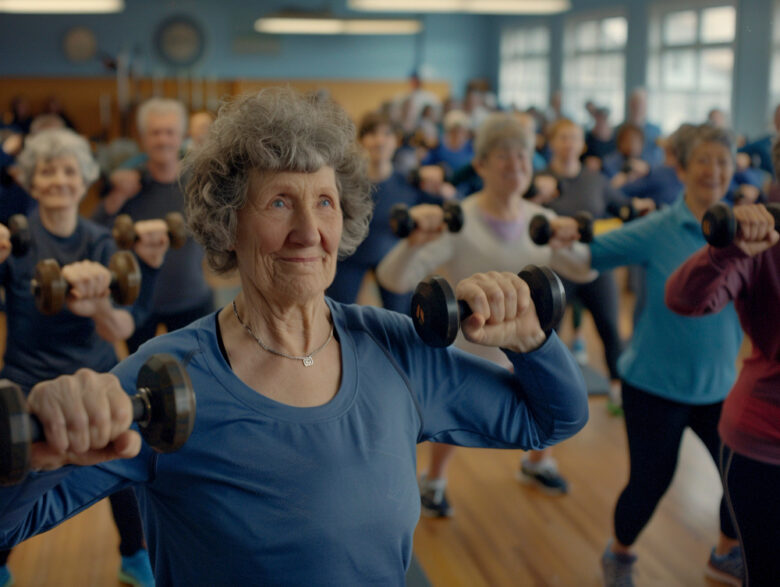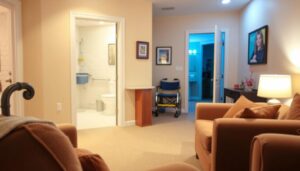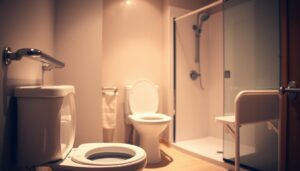Staying active becomes increasingly vital as we age. The CDC reports that falls occur every second among those 65+, leading to 32,000 deaths annually. Regular movement isn’t just about fitness—it’s a lifeline for maintaining independence and reducing risks.
Physical therapist Amy Cassady notes that simple daily activities strengthen bones, improve heart health, and boost emotional well-being. Her research shows consistent movement helps manage anxiety while fostering social connections—a critical factor for older adults.
This guide focuses on practical routines designed for safety and adaptability. Whether balancing near a countertop or seated stretches, each activity prioritizes stability. Small efforts add up: even 15 minutes daily can enhance coordination and confidence.
Building sustainable habits starts with understanding your body’s needs. Many worry about overexertion, but low-impact options provide gentle progressions. The key lies in consistency, not intensity—creating patterns that fit seamlessly into home environments.
Understanding Senior Mobility and Its Benefits
Joint function and full-body coordination form the foundation of independent living. While aging brings natural changes, targeted movement helps maintain essential capabilities. Let’s explore how these elements work together to support daily life.
What Makes Joints Work Smoothly
Healthy joints operate like well-oiled hinges, allowing pain-free motion through their full range. This functional movement prevents stiffness during routine tasks like reaching or bending. When hips, knees, and shoulders move freely, they reduce strain on surrounding muscles.
Total-body coordination goes beyond individual joints. It involves synchronized efforts between bones, tendons, and nerves. This teamwork enables complex actions – from walking upstairs to carrying groceries safely.
Whole-Person Wellness Connections
Regular activity strengthens the heart and bones while preserving muscle tone. Research shows even light routines boost mood and sharpen focus. A 12-week study found participants gained better balance and reported feeling more socially connected.
These benefits create a positive cycle: physical confidence encourages more movement, which further enhances health. Simple consistency matters most – small daily efforts yield lasting results for body and mind.
Getting Started with Simple Mobility Routines
Establishing a daily movement practice begins with proper setup. The CDC recommends 150 minutes of moderate activity weekly, achievable through short sessions spread across days. This approach helps maintain energy levels while reducing injury risks.
Preparing Your Space and Equipment
Clear a 5×7 foot area to move safely. Remove loose rugs or cords that could cause slips. Good lighting helps spot potential hazards during routines.
Use a sturdy, armless chair placed against a wall for stability. A yoga mat provides cushioning for floor-based movements. Keep water nearby and wear supportive shoes for comfort.
Start with five-minute sessions if new to activity. Gradually increase to 10-minute intervals three times daily. Consistency matters more than duration—small efforts build lasting habits over time.
Those managing health conditions should consult their doctor first. Track progress using a simple calendar or app. Celebrate small wins like completing three sessions a week to stay motivated.
Senior Mobility Exercises at Home
Maintaining physical independence requires adaptable movement strategies that prioritize safety and gradual progress. Focused routines using household items create accessible opportunities to build strength without specialized equipment.
Chair-Assisted Movements for Stability
Chair squats develop lower-body power essential for daily tasks. Position a sturdy seat behind you, stand with feet slightly wider than shoulders, and lower slowly while keeping knees aligned. This controlled motion strengthens thighs and improves sitting/standing transitions.
Wall push-ups offer upper-body conditioning with built-in support. Place palms flat against a wall at chest height, step back with feet shoulder-width apart, and bend elbows to lower toward the surface. This modification reduces strain while engaging chest and arm muscles.
Floor-Based and Standing Workouts
For those comfortable on the ground, seated leg lifts enhance hip flexibility. Sit tall with feet flat, then alternate extending each leg while maintaining posture. Standing variations include the Cactus Arms technique: raise arms overhead, then bend elbows to form right angles with palms forward.
Focus on alignment during all movements. Keep shoulders relaxed and core engaged to protect the spine. Start with 5-8 repetitions per side, gradually increasing as coordination improves. These adaptable methods ensure steady progress across fitness levels.
Flexibility and Stretching Routines for Older Adults
Maintaining full-body range of motion supports everyday tasks while reducing stiffness. Gentle stretches enhance posture and circulation, making movements like reaching or bending more comfortable over time.
Effective Stretching Techniques
Always start with a 5-minute warm-up like marching in place or arm circles. This prepares muscles and joints for deeper stretching while minimizing strain.
The overhead side stretch improves torso flexibility. Stand tall with feet apart, raise arms overhead, and lean gently to one side. Hold for 15 seconds while breathing deeply. Repeat on both sides.
For lower-body relief, try the soleus stretch. Place hands on a wall, step one foot back, and press the heel down. This targets calves and hamstrings without requiring floor work.
Utilizing Equipment for Enhanced Flexibility
A resistance band helps deepen shoulder and chest stretches safely. Sit upright in a chair, hold the band with both hands, and slowly lift it overhead. Keep movements controlled to avoid overextension.
Towels work well for seated leg stretches. Loop one around your foot while sitting, then gently straighten the knee. This supports gradual progress in hip and back flexibility.
Focus on steady breathing during all routines. Inhale before starting a stretch, then exhale as you move into position. This oxygenates muscles and improves relaxation.
Strength and Balance Workouts for Safer Movement
Building physical resilience through targeted workouts enhances stability in daily life. Focused routines strengthen critical muscle groups while improving coordination – key factors for confident movement patterns.
Chair Squats, Planks, and Bird Dog Exercises
Chair squats develop essential lower-body power for standing up safely. Position yourself in front of a sturdy seat, lower slowly while keeping knees aligned over toes, then rise using leg strength. This functional movement builds hip and thigh endurance.
Modified planks engage core muscles through controlled holds. Start on hands and knees, extend one leg back, then alternate sides. Bird Dog exercises challenge coordination by extending opposite arms and legs while maintaining spinal alignment.
Balance Training to Prevent Falls
Single-leg stands improve stability by strengthening ankles and calves. Hold onto a countertop if needed, lift one foot slightly, and maintain steady breathing. Gradually increase hold times as confidence grows.
The Tree Pose adaptation uses wall support for safer practice. Place one foot against the standing leg’s calf or thigh while keeping hands on hips. This posture enhances spatial awareness and reduces fall risks through repeated practice.
Consistent balance training sharpens reaction times during unexpected movements. Pair these routines with strength-building exercises for comprehensive protection against slips or missteps.
Cardio and Endurance Exercises to Boost Mobility
Heart-pumping activities play a vital role in maintaining energy levels and physical independence. Experts recommend 30 minutes of moderate-intensity movement 3-5 days weekly to support cardiovascular health and respiratory function.
Brisk Walking and Low-Impact Aerobics
Walking remains one of the most accessible workouts for improving circulation and managing chronic conditions. Aim for 10-minute sessions three times daily, gradually increasing pace to elevate heart rate without strain.
Water-based exercises provide joint-friendly alternatives. Aquatic movements strengthen muscles while reducing impact on knees and hips. Many community centers offer specialized classes combining social interaction with guided routines.
Incorporating Stair Climbing and Water Workouts
Stair stepping builds leg power crucial for daily tasks. Those without knee concerns can start with 2-3 flights, using handrails for support. This functional exercise enhances coordination while burning calories efficiently.
Swimming engages multiple muscle groups simultaneously, improving lung capacity and posture. Begin with 15-minute pool sessions, focusing on gentle strokes like breaststroke or water walking. These low-impact methods allow gradual endurance building.
Always consult healthcare providers before starting new routines. Track progress through simple metrics like walking distance or workout duration. Consistent effort yields lasting improvements in stamina and overall wellness.
Practical Tips to Stay Active and Prevent Falls
Maintaining an active lifestyle requires smart planning and safety awareness. Simple adjustments to daily routines can significantly reduce risks while boosting long-term health benefits.
Safety First: Smart Setup Matters
Always begin with a 5-minute warm-up like arm circles or seated marches. This prepares muscles and joints for activity. Choose shoes with non-slip soles and arch support to protect feet during workouts.
Keep a sturdy chair nearby for stability during standing movements. Clear floors of loose rugs or cords that could cause trips. Position your exercise area near a wall for extra support if needed.
Building Lasting Habits
Start with short 10-minute sessions twice daily, gradually increasing duration. Focus on proper form: distribute weight evenly between both feet during balance drills. Begin challenging moves on your non-dominant side first.
Track progress using a wall calendar or mobile app. Mild muscle fatigue is normal, but stop immediately if pain occurs. Consistency creates lasting results – three weekly sessions often yield noticeable improvements in stability and confidence.



